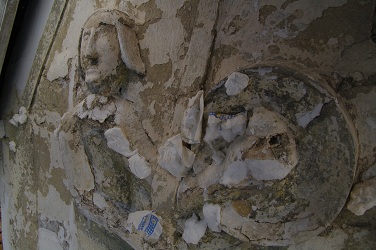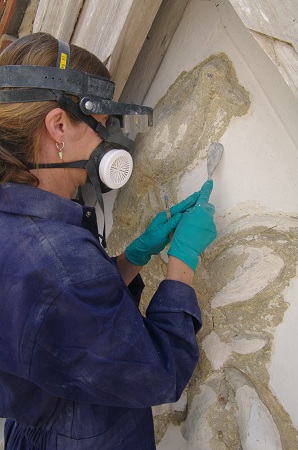Concern over Showpiece
The pargeting is believed to date from the 17th century, although the building has 14th-century origins and once formed part of the well-known old Sun Inn. Pargeting is a tradition associated particularly with north-west Essex. Many local examples are of the ‘incised’ type, scratched, combed or stamped into wet plaster. The pargeting on 25-27 Church Street, though, is of the much rarer and more skilled ‘relief’ form, modelled with the fingers and small tools. It includes two unique giant figures, together with birds, foliage, various architectural motifs, a dog and even a stocking.
The house is an important and much-photographed attraction on the town tourist trail, opens to the public by appointment and hosts frequent visits from history and architecture groups, as well as students.
The pargeting was regularly limewashed throughout the late 20th century but in 2009 the building’s new owner, historic building surveyor Douglas Kent, who is Technical and Research Director at the Society for the Protection of Ancient Buildings (SPAB), decided that a major campaign of work was unavoidable. His view was confirmed by leading plasterwork conservator Torquil McNeilage ACR, who undertook a close inspection of the pargeting with a cherry picker in 2010, followed the next year by a comprehensive survey from scaffolding, coupled with trails and paint analysis, to formulate detailed conservation proposals.

Long-term weathering plus inappropriate past repairs (employing cement instead of lime), roosting pigeons and structural movement had all taken their toll on the unique pargeting. Whilst much of the plasterwork was sound, certain areas were weak and it was questionable whether they could all be saved. There were holes, cracks and decayed plaster. In fact, the gable above the carriageway displaying the two large figures was so fragile that in 2011 it was boarded over for protection from the winter weather, pending work. So attached are the local people that the condition of the pargeting was causing grave concern.
Rescue
A once-in-a generation programme of specialised repairs using state-of-the art conservation techniques was undertaken by McNeilage Conservation in 2012, after the careful erection of full scaffolding by Essex firm Orion. The focus was on work essential to the long-term well-being of the pargeting, utilising sympathetic methods and materials and based on a good understanding of the history, construction and condition of the pargeting.
Weakened plaster was consolidated with liquid lime grout injected into cracks and small voids. Applications of nano-lime (very fine particles of calcium hydroxide carried in ethanol) were then sprayed or injected in some areas. Numerous ‘mortar repairs’ took place to fill generally small areas of lost plaster with a lime putty, hair, sand and chalk mix. The approach was to avoid conjecture but follow the broad line of the existing decorative detailing to maintain its integrity. Terracotta armatures and some stainless steel reinforcement gave additional support to the new plaster and a stainless steel rod was inserted to help restrain the head of the right-hand figure. The crude cementitious repairs were also taken out.

Additionally, thick paint layers still obscuring certain areas were removed to enhance the surface for redecoration and improve the readability of the plaster details. A ‘breathable’ finish was required that did not radically alter the building’s appearance yet offered better frost resistance than ordinary limewash and covered the grey underlying oil paint without excessive coats. After detailed on-site discussions with the Anglia Lime Company, a modified (‘pozzolanic’) limewash was applied, followed by a top coat of limewash containing magnesium stearate. Black, flint-like chips discovered for the eyes of the pargeted birds were left uncovered, as originally.
The work cost £29 000 (including VAT), although the owner’s direct project management provided major savings. The meticulous repairs should help ensure that the building is, in the words of SPAB founder William Morris, handed down ‘instructive and venerable to those that come after us’.
Back to top




